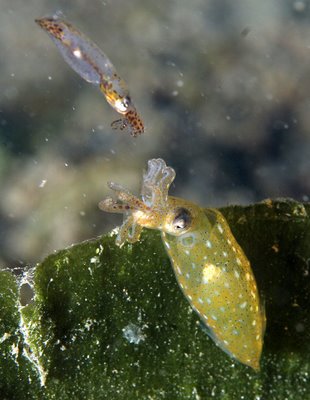Diane "Freak-eyes" finds the impossible once again.
These amazingly small animals are Two-toned Pygmy Squid,
Idiosopius pygmaeus (1cm and 2cm), the larger of which is at the maximum size for the species. Pygmy Squid are usually active by night and tend to hang out around sponges, soft corals, and gorgonians. In this case, they were attached to a Green Algae,
Udotea. The squid's back has a glue gland, producing an adhaesive mucus, that allows it to adhaere to seaweeds, seagrasses or other surfaces. Another gland produces the anti-glue, allowing rapid detachement.
We observed some rather interesting behavior from these two. When detached from the algae, the squids tended to engage in, what appeared to be, coupling. The smaller squid circled above the larger, and as in the second photo below, inserted its tentacles inside that of the other. It was almost as if the smaller squid was being fed by the larger. I have no idea if this even occurs in the species and it seems rather unlikely that the smaller squid couldn't hunt and eat on its own.













